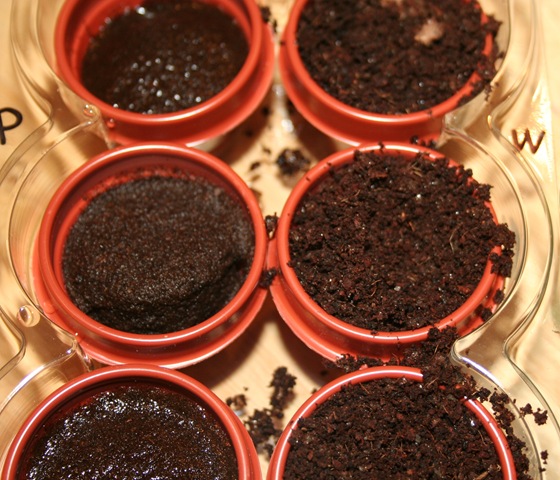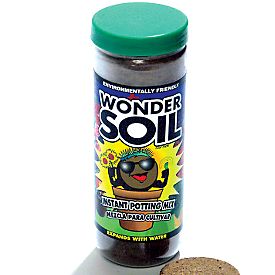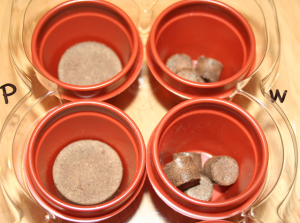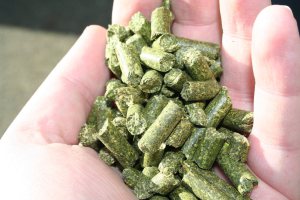Using used coffee grounds in your garden/compost
15.3 years ago cheap, compost, fertilizer
 I have wanted to leverage used coffee grounds in my garden/compost but not being a coffee drinker myself I never seemed to be able to have the right timing to find any at local coffee shops. Recently a colleague taunted me with a picture from his cell phone of a few bags in the coffee shop in our cafeteria at work and my quest began.
I have wanted to leverage used coffee grounds in my garden/compost but not being a coffee drinker myself I never seemed to be able to have the right timing to find any at local coffee shops. Recently a colleague taunted me with a picture from his cell phone of a few bags in the coffee shop in our cafeteria at work and my quest began.
After just two days I have accumulated 40 lbs of coffee grounds, now how can I use this stuff in my garden?
- Throw it in your compost: Coffee grounds are 1.45% nitrogen and contain calcium and magnesium to add some trace minerals you may not get from your other organic material. Coffee grounds are a green material (I know coffee is brown, but same idea as grass clippings) so you should add with at least equal amounts of brown material (leaves) but if you are like me my browns are way to high already.
- Add it directly to your garden: I have seen some arguments that coffee grounds are acidic, but others claim it loses most (or all) of its acidity during the brewing process. Due to my natural curiosity I need to know the answer. So the answer is, it has an average pH of 6.9 so for all intents and purposes, it is neutral. Though if you are really tired and forget to brew it, it will be somewhat acidic.
- Fertilizer: Sometimes your plants need a little boost in the morning as well. Simply add a couple cups of coffee grounds to a bucket of water and let it seep for 24 hours and apply to plant in the same way you would compost tea. Using gardener terms I can’t think of any better name for this as “coffee tea” If you are busy/lazy you also can use it as a side dressing on top of your soil and let the rain seep it for you.
- Annoy your pests to stay out of your garden: It has been said that coffee grounds can deter cats from using your garden as their own personal commode. There are also reports that it can deter slugs as well. I am not sure if it is the abrasive soil effect on their sensitive underside or just the cruel reality that with their slow pace they can’t do anything with the caffeine rush they get. Coffee grounds may annoy ants to convince them to move their home elsewhere.
- Feed your worms: To worms this stuff is like ice cream, if you listen carefully you may hear them cheer your name when you add a handful to your worm bin when your greens from the kitchen may be a little lacking.
According to Starbucks brochure I picked up on my last visit, you should use the coffee grounds within 3 weeks to get the most nutrient value, though if you are composting I am sure you can start out the process in the bag if you really want to. Given that 16.34 billion pounds of coffee is produced each year there is plenty for you to save from ending up in a landfill. This is a great way to help the environment while also adding value to your garden without affecting your pocketbook.
Tags: cheap, coffee grounds, compost, organic vegetables, outdoor plants, worms
Using WonderSoil for seed starting
15.3 years ago cucumbers, fertilizer, indoor seed starting, vermicomposting, wondersoil
I had great results using coconut coir last growing season it was great to work with, retained water great for young seedlings, and was economically priced. The only challenge was actually finding some to use this year. No luck in local stores, last year I only could find a single block in one hardware store. Online there are plenty of locations that sell them, but unless you have a need for a couple metric tons, the cost of shipping can be more than the the product itself.
Finally, I found a solution to my problem WonderSoil Their main product line consists primarily of the same core component but they sell it in many different convenient sizes for various uses. One great feature of the product is it expands up to 12 times its original size. For someone like myself that does not have the space to store bags of peat/potting mix around my already full garage this is a great feature. You can check out all of their products but the ones that felt matched my growing needs were the following:
- Shake, Water, and Plant — 1/2 inch mini wafers that can be added to any of your pots. In my case I underestimated the expansion of these little things and made a little mess and it overflowed on my table (apparently 3 was the magic number not 4)
- The Tube — There are larger wafers made specifically for 4 inch pots, in my case this would be newspaper pots
- Reground Wafers — This is basically a loose version available in 2 or 5 lb bags. This is a more economical option which I will plan on using when doing larger seed trays.
For Christmas I got indoor seed starting kit which came with pots/seeds/peat pellets. I decided this would be a great opportunity to do a little side by side comparison. From the start I was WonderSoil seemed like the obvious winner. After adding a little water, it fully expanded in just a few seconds and was fluffy and ready for me to drop a seed in, the peat was a swampy mess.

Peat pellets Left, WonderSoil Right
After a few minutes and fluffing with a fork the peat was ready to planting. I put cucumber seeds in both peat and WonderSoil pots and I will provide some updates on how things progress on my little experiment.
After the WonderSoil had some time to settle in my cheap LED grow box I did see some strange formations appear in the soil.
I little concerned I went back to their product and I believe this is their “water saving polymers” in action which I would assume is some sort of gel crystal which is supposed to save up to 50% water. They also boast about use of worm castings which I am definitely a fan of as well as addition of a balance of various micronutrients.
I will have to wait and see if the product produces as well as it claims, but I must say I am definitely impressed at this point and have high hopes for WonderSoil for this years seedlings.
UPDATES:
Christmas light LED grow box – Update #1 (WonderSoil)
Tags: cheap, compost, garden seeds, growbox, led, outdoor plants, vegetables, worms
Using alfalfa pellets as cheap organic fertilizer for your lawn and garden
16.2 years ago alfalfa pellets, cheap, fertilizer, organic
We all know if you walk into a grocery store the organic produce is always more expensive than produce grown using non-organic methods. Using deductive reasoning it seems easy to determine that this would mean growing vegetables organically will cost me more than if I used non-organic methods. What is a cheap vegetable gardener to do?
One disadvantage (and advantage) to organic fertilizer is that it is not as potent as chemical fertilizers. So my 2 lbs of organic will not nearly go as far (at least short term) as the same amount of chemical fertilizer. One trick to being cheap is to purchase products that are not being marketed for your planned purpose. So to solve my expensive fertilizer issue I used this same logic to solve the problem of finding a location to buy organic fertilizer that was not marketed as “fertilizer.” After some research I determined a source from my local feed store. For $10 I was able to get 25 lbs of alfalfa pellets compared to 2 lbs of alfalfa meal at my local nursery for around the same price.
One great thing about using organic fertilizer is my kids can help spread it around, unlike chemical fertilizers. It also contains triacontanol which is a root growth stimulant along with plenty of organic matter to help boost some extra microbial activity. This not only helps the grass but also improves your soil at the same time. By taking a few cups of alfalfa pellets and mixing with water you can also make alfalfa tea, which I am planning on doing later but will sure to let you know how it works out. One more tip, make sure you distribute the alfalfa pellets before a big rain or watering, currently my lawn looks like some geese are using it as their bathroom.
Tags: alfalfa pellets, cheap, organic vegetables, vegetables






